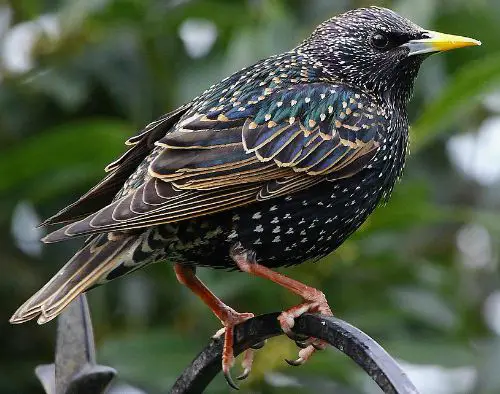|
Starling Hazing By David Tong  The European Starling, (Sturmus vulgaris), is a medium-sized bird some 7.5 - 9.0 inches in length, with triangular wings that span about nine inches. They are highly maneuverable in flight. In England, they are simply known as starlings and they came to North America in the early 1890s. It appears that some misguided individuals decided it would be a good idea to export all birds mentioned by Shakespeare in his plays to the New World and roughly 34 breeding pairs were released into New York. Worldwide, there are approximately 310 million starlings, while in North America we have approximately 154 million of them. They are considered pests by most farmers or those engaged in agriculture and most states have declared them unregulated by hunting statutes or control due to sheer numbers. I have recently taken a job hazing, or harassing/scaring starlings off some nearby wine grape vineyards. Starlings will annually do great crop damage starting in September through October, so this is no small financial matter for local businesses here in Oregon's Willamette Valley, an acclaimed grape/wine area. This hazing is done by merely driving through the vineyards, honking the horn, walking in them and shooting a shotgun in their general direction. The idea not necessarily being to kill them, as it would be impractical to significantly reduce their numbers, but to make them think twice about eating grapes. Starlings are birds that generally travel in large flocks and it is not uncommon to see hundreds of them in a single group. It does not take much imagination to consider how much grape destruction several of these groups can do to a vineyard. Pinot Noir and Chardonnay grapes are ripe for picking in mid-September. Starlings like to perch in groups on phone lines or on the tops of tall evergreens to get a bird's eye view of the terrain to see where people are, before descending en masse to eat grapes. I am convinced this is learned behavior. On successive days, I watched hundreds of starlings take flight as my car or truck arrived on site at the Chardonnay vineyard, circle in the sky, and fly away as I racked my pump shotgun's action. They were just as quick to return when they heard my car door shut, as I was about to drive away. Birds are much smarter than many folks realize. Since the vineyards in the area where I am patrolling are bordered by roads, I must be cognizant of my field of fire and limit the direction I shoot to avoid the possibility of spent shot falling on vehicles. Thus, I generally set up in the middle of a field, roughly 100 yards in any direction from any road. I have used three pump action shotguns to accomplish this work. The first was a Mossberg M590A1, the USMC issue cylinder bore with aperture and blade sights. Needless to say, this amount of visual clutter atop the receiver was a pain to use for wing shooting, but the shotgun proved effective for scaring away birds. I did have some last round failures to feed at the end after firing some 400 rounds of 12 gauge Winchester-Western one ounce field loads at 1300 fps. I think the magazine spring needs replacing. When those malfunctions started, I requested another shotgun from the company and they issued me a pair of identical Remington 870s. These were low line RemChoke guns with 28 inch barrels, Parkerized metal finish and laminated wood stocks. Both of these shotguns experienced failures to extract, necessitating my use of a Swiss Army knife's small flat-bladed screwdriver to remove the offending case from the extractor cut in the chamber. Needless to say, both shotguns were hors de hazing in short order. Finally, my supervisor lent me his dad's old J.C. Higgins Model 20, a 12 gauge pump with a 26 inch barrel topped by a Poly-Choke. This shotgun was manufactured by High Standard as their Model 200. The bolt is of the tilting variety, whose rear end locks upward into a receiver cut, rather than into a barrel extension, as most modern pump repeaters do. It was also more reliable and operated smoother than the modern 870s I had been using. (Most guns will smooth out after 50 years of use. -Editor.) The factory ventilated rib on the barrel and the matching rib on the receiver were finished and milled together with squiggled matting to a very fine fit. I like this gun a lot and the Poly-Choke makes the choke constriction instantaneously adjustable by twisting its serrated ring from cylinder to extra-full. There are soft detents at each choke setting. This shotgun, made from the late 1940s to about 1962, is a joy to use and now I want one of my own. That, or a similarly equipped Winchester Model 12. By this point, you are probably wondering, "Did you shoot any starlings?" The answer is "Yes." By shooting into large flocks of them, the occasional bird falls prey to the pattern. (How many are wounded is unknown.) I consider myself a bird fancier of sorts, mostly the parrot group, and I enjoy their vivid personalities. I take no particular joy or satisfaction in killing starlings, but recognize it is part of my job. I had previously shot at no birds, besides clay ones at a skeet or trap range. I can only say that starlings are worthy aerobatic adversaries. They fly in irregular patterns, horizontally and vertically, and are quite difficult to hit. I wish that they didn't need to be culled, but there you are. Blame some guy in England who took it upon himself to export them to our country a 130 years ago. |